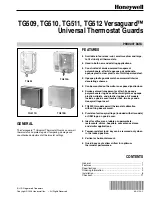
RTX430-3QR User Manual
9
c. The LCD will display “Select RAID Type”. Press
Up
or
Down
to cycle through to your desired
RAID type and then press
Enter
to confirm your selection.
d. The screen will display “Will Erase all Data OK?” Pressing
Enter
will result in the loss of all data
on the drives. Ensure all of your data is backed up, then press
Enter
.
e. The new configuration will be selected and the RTX enclosure will reboot. The RAID is now
created.
5.3 Add a New Drive to an Existing RAID
Follow these steps to add a new drive to an existing RAID. This is necessary if you are replacing a
failed hard drive within a RAID 1, RAID 5, or RAID 10, or if you are adding an additional drive to a
RAID 1, RAID 5, or RAID 10.
d. Remove the failed hard drive (if applicable).
e. Insert a new hard drive in an empty TrayFree drive bay.
f. After the hard drive spins up, the RTX unit should detect the drive. The LCD will ask to add a
new disk. Press
Enter
to do so.
The disk will now be added to the RAID and the RAID will begin to rebuild. A 1TB hard drive takes
just over three hours to rebuild. To display the approximate remaining time on the LCD display, press
Enter
.
6 Usage with Windows and macOS Operating Systems
6.1 Usage with Windows Operating Systems
6.1.1 Format a Drive
When you first mount a drive to a Windows operating system, a pop-up window will ask you if you
would like to format it. Click
Format Disk
and skip to Step E in the instructions for your oper-
ating system below. If the prompt does not pop up, use the Disk Management utility by following
the steps below for your specific Windows operating system:
Windows 10
a. Right-click on the
Start Button
and then select
Disk Management
.
b. The drive should appear in the list of Disks in the lower pane. You may need to scroll
down to see it. If the drive is already formatted, you can identify it easily by its volume
name. If the drive is not initialized or is brand new, a window will pop up asking you to
select a partition type. Select
GPT
and press
OK
.


































